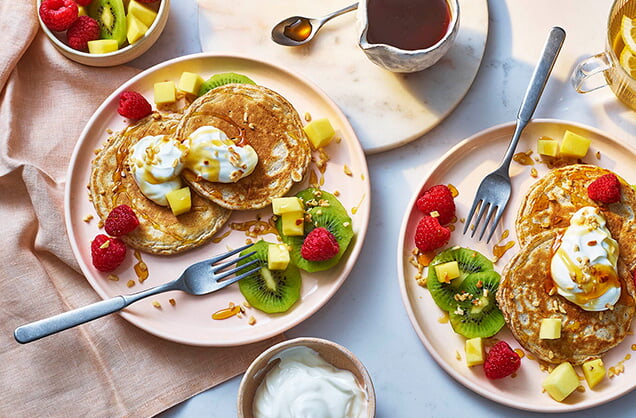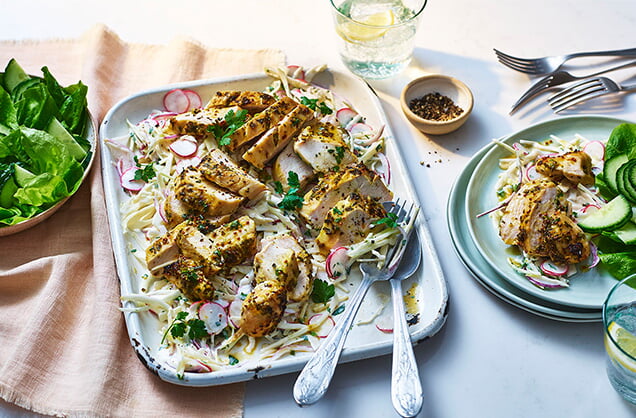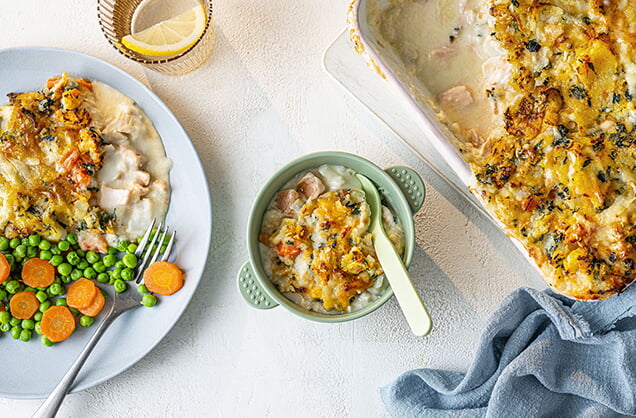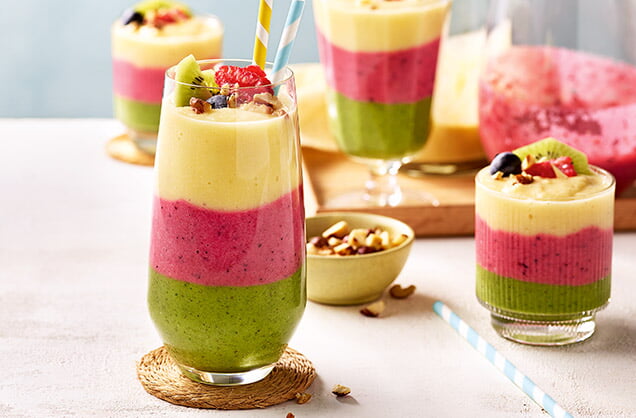Healthy eating guidelines
It might help to have some guidelines in your head when you’re making food choices. That’s where Reference Intakes come in. Reference Intakes (RIs) are the new term for Guideline Daily Amounts (GDAs). They are guidelines about the approximate amount of particular nutrients and energy required for a healthy diet. It does depend on lots of different factors, such as age, height, weight, gender, and how physically active you are, so, these RIs are guidelines, not rules, on how much we should eat and drink.
You will spot RIs on lots of food packaging; the information will usually give you an idea of portion size (not just the values per 100g), so you have an idea of what a suggested portion looks like. RIs include the energy of the food (kilojoules/calories) as well as fat, sugars and salt.
What is the traffic light system?
While this is not required by law for pre-packed food, many foods do include front-of-pack nutrition labels. It helps you see at a glance, whether a food has high, medium or low amounts of fat, saturated fat, sugars and salt. ‘Red’ means a product is high in a nutrient such as saturated fat and you should try to eat these foods less often and in small amounts. If the nutrient is amber, you can eat it most of the time, and if it’s green it’s low in this nutrient (such as saturated fat and salt). In general, all or mostly ‘greens’ means a healthier choice.
RIs on recipes
All our recipes include the nutritional information including RIs, to make it easier for you to choose what to eat and plan your meals with a balanced diet in mind. It doesn’t mean you have to avoid recipes with ‘reds’, just be mindful of eating these recipes less often and as treats, or in smaller portions. It’s also worth knowing that our healthy recipes contain only ‘greens’ and ‘ambers’, to make it simpler to follow a balanced diet.

The Eatwell Guide
If you like to visualise a balanced diet and what healthy foods to eat every day, The Eatwell Guide could help. It’s like a healthy eating plate, showing you approximately how much of each food group should make up your diet. Don’t worry, you don’t have to achieve the exact amount with every meal, it’s about finding a good balance over the day and often over the week.
Did you know?
Fruit and vegetables should make up just over a third of the food we eat each day.
5-a-day
Launched in 2003 to encourage the nation to eat more fruit and veg, the ethos of 5-a-day is to eat at least 5 portions of fruit or vegetables (around 400g) daily for good health. If you’re wondering how to eat better, 5-a-day is a great first step and could help lower the risk of developing serious health conditions. It needn’t be an expensive way to eat either – think seasonal fruit and veg, which is often more affordable than other varieties, and remember budget-friendly frozen, tinned and dried fruit and veg all count towards your portions. More good news: we’ve plenty of 5-a-day tips and tasty recipes and some new ways to get your 5-a-day that we hope will inspire you to up your portions.

Vitamins and minerals
Vitamins and minerals are nutrients our body needs to stay healthy, and most people should get all the nutrients they need by having a varied and balanced diet, although some may need extra help with supplements. You probably know that vitamin C can support immune function and vitamin D can be absorbed from sunlight, but it’s worth knowing a little about all the vitamins and minerals and how you can get them from your diet. The NHS has a useful guide, plus we’ve some clever tips and recipes for combining foods to give you the most nutritional impact.
Carbohydrates
Carbohydrates, or starchy foods, should make up just over a third of the food we eat. They’re a good source of energy and can be a good source of fibre, calcium, iron and B vitamins. Choose higher fibre or wholegrain carbohydrates wherever possible, such as wholemeal bread, wholewheat pasta, brown rice and wholegrain cereals. These wholegrain starchy foods contain insoluble fibre that cannot be digested, which helps other food and waste products to move through the gut. This in turn can keep your bowels healthy and can help you feel full.
Protein
Protein is essential for the body to grow and repair itself; aim to eat around 45g of protein a day if you’re a woman; 55g if you’re a man, although this is a rough guide as it does depend on your weight and other factors. Beans, pulses, fish, eggs and meat and are all good source of protein as well as some vitamins and minerals. Meat can be a good source of iron, zinc and B vitamins, especially B12, but try to cut down on the amount of processed meat you eat, such as bacon, ham and sausages. This is because processed meat can be high in saturated fat and salt and can increase your risk of, or contribute to health problems such as heart disease and high blood pressure.
Aim to eat at least two portions of fish a week, including one portion of oily fish, which is rich in omega-3 fatty acids. Tinned fish is a brilliant, budget-friendly option and still contains lots of nutrients. Check out these budget healthy meals for lots of tasty, affordable ideas, and, if you’d like to become a pro at protein, have a read of our guide to protein and high-protein foods and browse our carefully devised high-protein meals and recipes.
Fats
Some may think fats are ‘bad’ for a healthy diet, but not all fats are made equal! We all need a small amount of fat in our diet, as it’s a source of fatty acids that our body can’t produce; fat also helps us absorb vitamins A, D and E. The key to a healthier diet is to limit saturated fat – aim for no more than 30g if you’re a man and 20g if you’re a woman, children should have less. This is because saturated fat can increase the amount of cholesterol in the blood and increase your risk of heart disease. Saturated fat can be found in some red meats, butter and cheese, pastries, cakes and biscuits. Try to swap this type of fat for healthier, unsaturated fat found in foods like olive oil, avocado, some nuts and oily fish like salmon, sardines and mackerel. Find out more with our quick guide to fats from nutritionist Laura Matthews.
Is salmon healthy to eat?
The short answer is yes. Salmon contains more calories and fat than some fish, but it also contains lots of nutrients, so it can be enjoyed as part of a healthy, balanced diet. Fresh and tinned salmon is a great source of omega-3 fatty acids, as well as being a good source of protein and naturally rich in vitamin D. If you’re buying fresh or frozen salmon, look for MSC-certified fish, which means it has been sustainably sourced from a fishery that meets the Marine Stewardship Council’s high standards.

Sugars
Have you heard of the term ‘free sugar’? It refers to sugar added to sweets, biscuits and fizzy drinks, as well as naturally occurring sugar in fruit juice and honey. Free sugar should make up no more than 5% of the energy you get from food and drink each day – that’s around 30g for an adult daily, less for children. Most of us consume too much sugar, but don’t worry, there’s no need to go sugar-free for a healthy, balanced diet. Be mindful of how much you’re consuming, keeping an eye out for hidden sugars, particularly in processed foods. If you like a sweet treat, why not make a healthy bake or healthy dessert? These recipes contain ‘greens’ or ‘ambers’ for sugar content, based on the traffic light system, explained above.
It's reassuring to know that sugars that occur naturally in whole fruit and veg can be eaten freely within a healthy, balanced diet. Plus, whole fruit provides us with useful nutrients such as fibre, vitamins and minerals. Make the most of fresh, seasonal fruit with our creative fruit dishes. Here you’ll find a mix of healthy recipes and treats, which you can enjoy occasionally – balance is key!
Salt
It’s easy to consume too much salt, it’s often added to so many pre-packed foods, including bread and cereal, as well as traditionally salty foods like processed meats and cheese. Aim for no more than 1 teaspoon (6g) daily – that includes the salt you add during and after cooking. Add flavour with herbs, spices, pepper, garlic and lemon. Keep an eye on food labels where possible and cut down on ‘reds’ for salt content.
Fibre
Eating more fibre is beneficial for everyone, not just people with digestive problems or constipation. Why? Because it helps to keep your whole body healthy, lowering the risk of heart disease, type 2 diabetes and bowel cancer. Aim for 30g of fibre a day by choosing wholegrain foods such as wholemeal bread, wholewheat pasta and cereals, as well as boosting your intake of fruit, veggies, pulses (beans, lentils etc), nuts and seeds. Read our guide to fibre and high-fibre foods, then discover our high-fibre meals and recipes.
Gut health
The benefits of fibre just keep coming! Did you know it’s essential to our gut health? ‘Dietary fibre can’t be digested by human cells, essentially making it food solely for your gut bacteria instead,’ explains Dr Megan Rossi, gut health scientist and doctor. So, what is your gut bacteria exactly? Otherwise known as gut microbiome, it affects thousands of functions in our body and plays a major role in our overall health and wellbeing. Find out more in our simple guide to improving your gut health, where you’ll find lots of interesting facts and tips from Dr Megan, plus some delicious gut-friendly recipes.

Dairy and dairy alternatives
Dairy products are good sources of protein, calcium and some vitamins, and can form part of a healthy, balanced diet. Try to choose lower-fat and lower-sugar options such as semi-skimmed milk, reduced-fat cheese and plain (natural and unsweetened) yogurt. If you can’t have dairy or choose not to, there are plenty of delicious dairy-free alternatives – look for products fortified with calcium and vitamins for extra nutrients – then browse our dairy-free recipes for inspiration.
Hydration
Staying hydrated goes hand in hand with healthy eating and looking after our body. Drinking fluids regularly also prevents dehydration and avoids us overeating when we’re actually thirsty. The Eatwell Guide recommends we drink 6-8 glasses of fluid a day, but you may need more in hot weather, if you’re exercising, breastfeeding or recovering from illness. Water is an easy and cheap way to stay hydrated – try adding some fresh fruit to keep things interesting. You can also opt for low-fat milk, sugar-free drinks, tea and coffee (consume caffeinated drinks in moderation). Just remember to limit fruit juice to 150ml a day with a meal, as it’s high in sugar – you could try diluting juice to make it go further.
Healthy eating for all the family
Making good food choices can have a positive effect on our family’s health as well as our own, which is particularly important for children who need energy and nutrients to grow. We’ve plenty of healthy family meals and tasty kids’ meals to keep everyone satisfied, plus check out our quick healthy meals, healthy breakfasts, healthy lunches and healthy snack recipes for nutritious ideas to keep all the family fuelled throughout the day.
Although RIs vary slightly for children, depending on their age, general healthy eating guidelines apply to kids too. So, if you’re striving to follow a varied and balanced diet, it’s reassuring to know it will benefit all the family’s health. If you want to learn more, take a look at the NHS’s advice on what to feed young children; they also have tips for feeding babies and toddlers. You may be interested in our baby weaning recipes that have been created to be suitable for the different stages of weaning, from around 6 months to 12+ months.

Type 2 diabetes
Did you know 3.7 million people in the UK live with type 2 diabetes and another 12.3 million are at risk of developing it? That’s 18% of the population. If you’ve recently been diagnosed with type 2 diabetes or prediabetes, it can feel overwhelming, but it’s good to know that following a healthy, balanced diet and maintaining a healthy weight are key to managing the condition. Have a read of our simple guide to eating well with type 2 diabetes and prediabetes to get you started; you can also browse our balanced diabetes recipes, and healthy eating meal plan, approved by Diabetes UK.
Heart health
We all need to look after our hearts, whether we have a heart condition or not, and we can take a step in the right direction by eating a healthy, balanced diet. There are no special guidelines here – simply use The Eatwell Guide, with a focus on increasing your fruit and veg portions and cutting back on foods containing high levels of saturated fat, sugar and salt. Take a look at our nutritionally balanced heart healthy recipes, approved by the British Heart Foundation for inspiration.
Healthy eating on a special diet
If you want to eat well on a special diet (such as vegetarian, vegan, dairy-free or gluten-free), the same healthy eating guidelines apply: consider a balance of food groups and nutrients, while keeping an eye on portion size. Here are a few other points to bear in mind on a special diet:
Vegetarian and vegan
If you’re veggie, focus on fruit, vegetables, wholegrains, and protein from beans, pulses, eggs and dairy (dairy is also a good source of calcium). Ensure you eat iron-rich food such as dark green leafy veg, lentils, tofu, dried fruit and fortified cereals. Check out our healthy vegetarian recipes, plus discover all of our vegetarian recipes for lots more meat-free ideas. If you follow a vegan diet or just fancy a plant-based meal, we’ve lots of exciting vegan recipes, some healthy, some less healthy, but remember it’s all about balance. Or browse our healthy vegan recipes for dishes with ‘greens’ and ‘ambers’.
Is eating vegan healthy for you?
Eating vegan, that is a plant-based diet, can certainly be healthy for you. Make sure you include the five food groups in your diet: fruit and veg, carbohydrates, dairy alternatives, protein and fat. Pulses are an affordable, versatile and tasty way to include protein in a vegan diet – see our quick guide on how to use pulses for lots of creative ideas.
Dairy-free
There are many reasons why you may follow a dairy-free diet or want to cut down on the amount of dairy you eat. Dairy is a source of calcium, so it’s key to still include this nutrient in your diet. You can find calcium in many plant-based milk alternatives, dark green leafy veg, tofu and fish with bones (such as tinned sardines). Browse our dairy-free recipes, from simple dinner ideas to tempting desserts – some are naturally dairy-free, some will contain dairy-free alternatives.

Gluten-free
A gluten-free diet means avoiding the protein found in wheat, barley and rye. If you have coeliac disease, you must avoid all traces of gluten, which means checking the ingredients list on food packaging. Following a gluten-free diet doesn’t mean missing out on tasty meals and treats – our gluten-free recipes include all your favourites, plus lots of new ideas. You can also find a wide range of gluten-free products in the Free From range.
Finding a balance
There are times when we all want to ease up on healthy eating. Perhaps you fancy a dessert, cake or fakeaway or you want to enjoy some celebration food for special occasions like birthdays or Christmas. If you have a goal in mind such as reaching a healthy weight, you may prefer a healthy bake, healthy dessert or a healthy comfort food classic. But don’t feel guilty about treating yourself, just remember moderation is key in a balanced diet. Healthy eating should be an achievable, sustainable way of life, not a strict diet, so, have fun with your food and enjoy exploring all our recipes. We hope you find some new favourites – be sure to let us know which – and do share any tasty recipe twists you’ve tried and loved!
